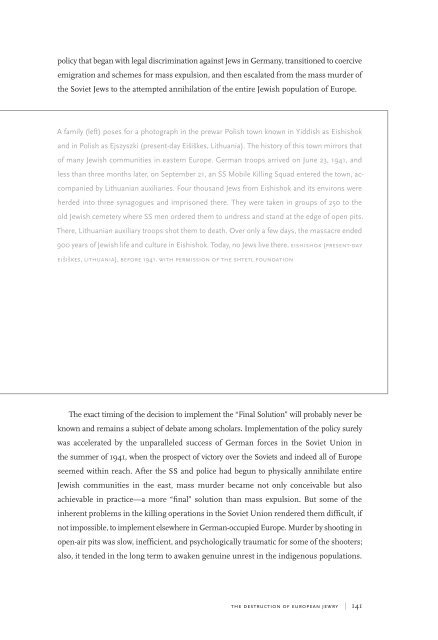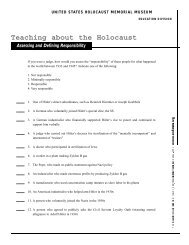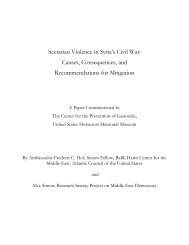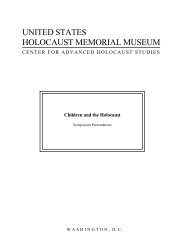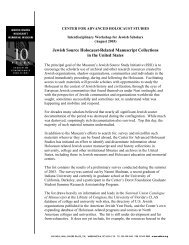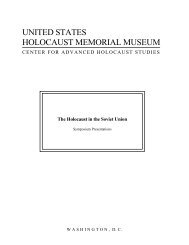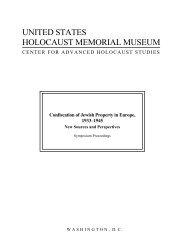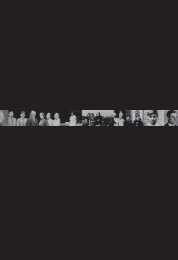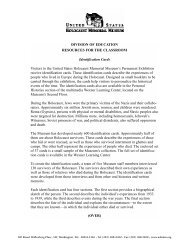the quest for racial purity - United States Holocaust Memorial Museum
the quest for racial purity - United States Holocaust Memorial Museum
the quest for racial purity - United States Holocaust Memorial Museum
You also want an ePaper? Increase the reach of your titles
YUMPU automatically turns print PDFs into web optimized ePapers that Google loves.
policy that began with legal discrimination against Jews in Germany, transitioned to coercive<br />
emigration and schemes <strong>for</strong> mass expulsion, and <strong>the</strong>n escalated from <strong>the</strong> mass murder of<br />
<strong>the</strong> Soviet Jews to <strong>the</strong> attempted annihilation of <strong>the</strong> entire Jewish population of Europe.<br />
A family (left) poses <strong>for</strong> a photograph in <strong>the</strong> prewar Polish town known in Yiddish as Eishishok<br />
and in Polish as Ejszyszki (present-day Eisˇisˇkes, Lithuania). The history of this town mirrors that<br />
of many Jewish communities in eastern Europe. German troops arrived on June 23, 1941, and<br />
less than three months later, on September 21, an SS Mobile Killing Squad entered <strong>the</strong> town, ac-<br />
companied by Lithuanian auxiliaries. Four thousand Jews from Eishishok and its environs were<br />
herded into three synagogues and imprisoned <strong>the</strong>re. They were taken in groups of 250 to <strong>the</strong><br />
old Jewish cemetery where SS men ordered <strong>the</strong>m to undress and stand at <strong>the</strong> edge of open pits.<br />
There, Lithuanian auxiliary troops shot <strong>the</strong>m to death. Over only a few days, <strong>the</strong> massacre ended<br />
900 years of Jewish life and culture in Eishishok. Today, no Jews live <strong>the</strong>re. eishishok (present-day<br />
eisˇisˇkes, lithuania), be<strong>for</strong>e 1941. with permission of <strong>the</strong> shtetl foundation<br />
The exact timing of <strong>the</strong> decision to implement <strong>the</strong> “Final Solution” will probably never be<br />
known and remains a subject of debate among scholars. Implementation of <strong>the</strong> policy surely<br />
was accelerated by <strong>the</strong> unparalleled success of German <strong>for</strong>ces in <strong>the</strong> Soviet Union in<br />
<strong>the</strong> summer of 1941, when <strong>the</strong> prospect of victory over <strong>the</strong> Soviets and indeed all of Europe<br />
seemed within reach. After <strong>the</strong> SS and police had begun to physically annihilate entire<br />
Jewish communities in <strong>the</strong> east, mass murder became not only conceivable but also<br />
achievable in practice—a more “final” solution than mass expulsion. But some of <strong>the</strong><br />
inherent problems in <strong>the</strong> killing operations in <strong>the</strong> Soviet Union rendered <strong>the</strong>m difficult, if<br />
not impossible, to implement elsewhere in German-occupied Europe. Murder by shooting in<br />
open-air pits was slow, inefficient, and psychologically traumatic <strong>for</strong> some of <strong>the</strong> shooters;<br />
also, it tended in <strong>the</strong> long term to awaken genuine unrest in <strong>the</strong> indigenous populations.<br />
<strong>the</strong> destruction of european jewry | 141


